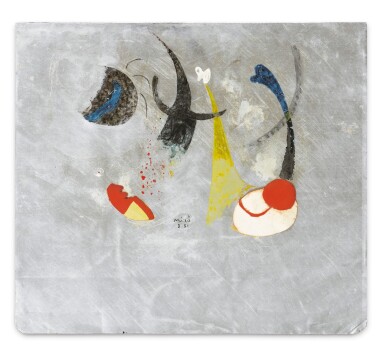
Property from a Private European Collection | Provenant d'une collection particulière européenne
Painting
Lot Closed
December 10, 02:14 PM GMT
Estimate
100,000 - 150,000 EUR
Lot Details
Description
Property from a Private European Collection
Joan Miró
1893 - 1983
Painting
signed Miró and dated 3.31 (towards lower centre); signed Joan Miró and dated 3-31 (on the reverse)
oil and collage on metal
18,1 x 20 cm; 7⅛ x 7⅞ in.
Executed in March 1931.
__________________________________________________________________________
Provenant d'une collection particulière européenne
Joan Miró
1893 - 1983
Painting
signé Miró et daté 3.31 (vers le bas au centre); signé Joan Miró et daté 3-31 (au dos)
huile et collage sur métal
18,1 x 20 cm; 7⅛ x 7⅞ in.
Exécuté en mars 1931.
Georges Hugnet, Paris
Private collection, Paris (acquired from the above)
Sale: Sotheby's, Paris, December 8, 2011, lot 24
Acquired at the above sale by the present owner
__________________________________________________________________________
Georges Hugnet, Paris
Collection particulière, Paris (acquis auprès du précédent)
Vente: Sotheby's, Paris, 8 décembre 2011, lot 24
Acquis lors de cette vente par le propriétaire actuel
Jacques Dupin & Ariane Lelong-Mainaud, Joan Miró, Catalogue Raisonné, Paintings, 1931-1941, Paris, 2000, vol. II, no. 344, illustrated p. 28
__________________________________________________________________________
Jacques Dupin & Ariane Lelong-Mainaud, Joan Miró, Catalogue Raisonné, Paintings, 1931-1941, Paris, 2000, vol. II, no. 344, reproduit p. 28
By 1931, Joan Miró was fully committed to the Surrealist project. After his initial move to Paris in 1922, the artist established close contact with André Breton, André Masson, Max Ernst, Jean Arp and Paul Éluard. Following his first one-man show in the United States in 1930, the artist’s overtly experimental style secured his international reputation; his revolutionary collages of 1929 and anti-painting objets of 1930 were followed by artworks dedicated to innovative technique, an economy of pictorial means and the use of non-artistic materials. As Miró famously told Francisco Melgar, during the journalist’s visit to his Paris studio in January 1931: ‘I intend to destroy, destroy everything that exists in painting’ (quoted in Miró and the Object (exhibition catalogue), Fundació Joan Miró, Barcelona, 2015, p. 24).
This crisis of "anti-painting" translates from 1930 through the experimentation of new techniques and new materials in his art. 1931 is thus the year of superpositions of materials, collages and "paintings-objects". The technique of collage, in particular, occupies a preponderant part in the work of the artist. Miró does not conceive collage in the way of Cubist artists but decides to apply it to new supports, creating new associations such as paper and wood on aluminum support. The present lot is one of the two paintings on aluminium by Miró known at this time.
__________________________________________________________________________
Dès 1931, Joan Miró s’engage pleinement dans le mouvement surréaliste. L'artiste déménage à Paris en 1922, et fréquente alors d'importants protagonistes du mouvement comme André Breton, André Masson, Max Ernst, Jean Arp ou encore Paul Éluard. Sa première exposition personnelle aux Etats-Unis s’ouvre en 1930. Son style expérimental lui assure une notoriété d'envergure internationale ; ses collages de 1929 et ses objets « anti-peinture » de 1930 seront suivis par une production artistique d'œuvres consacrées à la fois à une technique innovante et à l'utilisation de matériaux non-artistiques. Comme Miró l'a dit à Francisco Melgar, lorsqu'il a accueilli ce dernier dans son studio parisien en janvier 1931 : "Je veux détruire, détruire tout ce qui existe dans la peinture" (Miró et l'objet, catalogue de l'exposition, Fundació Joan Miró, Barcelone, 2015, p. 24). Cette crise de "l'anti-peinture" se traduit à partir des années 1930 par l'expérimentation de nouvelles techniques et de nouveaux matériaux dans son art. Les œuvres de l'année 1931 se caractérisent par des superpositions de matériaux, des collages et des "peintures-objets".
La technique du collage, en particulier, occupe alors une part prépondérante dans le travail de l'artiste. Miró ne conçoit pas le collage à la manière des artistes cubistes mais décide de l'appliquer à de nouveaux supports, mixant par exemple le papier et le bois sur un support en aluminium. Cette œuvre est l'une des deux peintures sur aluminium de Miró connues à ce jour.
You May Also Like










